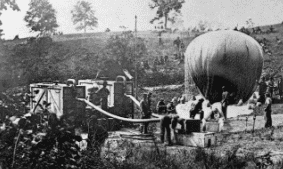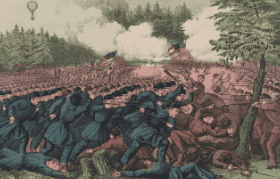When we think of the Civil War, images of infantry charges, artillery barrages, and cavalry skirmishes often come to mind. But did you know that one of the war’s most innovative and daring units took to the skies in hot air balloons? That’s right, the Union Army’s Balloon Corps was a remarkable chapter in military aviation history, filled with fascinating characters, daring exploits, and technological ingenuity. Let’s explore the story of these sky-high pioneers and their contributions to the Civil War.
The Birth of the Balloon Corps
The idea of using balloons for military reconnaissance wasn’t entirely new. Balloons had been used sporadically for observation purposes since the late 18th century. However, it wasn’t until the Civil War that the United States saw the potential of balloon reconnaissance on a larger scale.
Enter Thaddeus S. C. Lowe, an innovative aeronaut and scientist passionate about ballooning (See photo immediately below for a shot of Thaddeus in action; source: Library of Congress). In 1861, Lowe met with President Abraham Lincoln and demonstrated the potential of his balloons for military use. Lowe’s demonstration involved ascending in his balloon, the Enterprise, from the National Mall in Washington, D.C., and telegraphing a message back to the ground, showcasing the possibilities of aerial reconnaissance. Impressed by Lowe’s ingenuity, Lincoln gave his blessing for creating the Union Army Balloon Corps.

The Formation of the Corps
With Lincoln’s support, Lowe was appointed Chief Aeronaut of the newly formed Balloon Corps. The Corps was an unconventional unit with several balloons, portable hydrogen gas generators, and a team of skilled balloonists and support personnel. These balloons were tethered to the ground with long cables, allowing them to ascend to heights of up to 1,000 feet and provide a bird’s-eye view of enemy positions.
The primary mission of the Balloon Corps was to gather intelligence on Confederate troop movements, fortifications, and battlefield conditions. From their lofty vantage points, balloonists could spot enemy camps, artillery placements, and supply routes, providing invaluable information to Union commanders.

The Balloon Corps in Action
One of the first significant deployments of the Balloon Corps was during the Peninsula Campaign of 1862, a major Union offensive aimed at capturing the Confederate capital of Richmond, Virginia. Lowe and his team established several balloon stations along the route, including notable locations like Yorktown and Fair Oaks.
At the Battle of Seven Pines, Lowe’s aerial observations proved crucial. Lowe spotted Confederate reinforcements moving to attack Union positions from his balloon, the Intrepid. His timely warnings allowed Union forces to prepare for the assault, helping to prevent a potential disaster. Throughout the campaign, Lowe and his fellow balloonists provided continuous intelligence, earning the respect and appreciation of many Union officers.

Challenges and Innovations
Operating a balloon corps during wartime came with its fair share of challenges. Inflating the balloons required large amounts of hydrogen gas, which was produced on-site using portable gas generators. These generators, invented by Lowe himself, used sulfuric acid and iron filings to produce hydrogen—a dangerous and logistically complex process.
Additionally, the balloons were vulnerable to enemy fire. Tethered to the ground, they were relatively easy targets for Confederate sharpshooters and artillery. To mitigate these risks, balloonists often operated at higher altitudes, making them harder to hit, though this also limited the clarity of their observations.

Despite these challenges, the Balloon Corps continued to innovate. Lowe experimented with various balloon designs, including multi-chambered balloons for increased stability and observation platforms for better visibility. He also developed a mobile hydrogen gas production unit mounted on a flatbed railcar, allowing for quicker and more efficient balloon deployments.
Notable Figures and Their Stories
The Balloon Corps attracted a colorful cast of characters, each with their own unique stories and contributions. One such figure was James Allen, a skilled aeronaut who served as Lowe’s chief assistant. Allen’s technical expertise and bravery were instrumental in many successful reconnaissance missions.
Another notable balloonist was John LaMountain, a rival of Lowe who briefly operated his own balloon unit before merging with the Balloon Corps. LaMountain’s independent spirit and determination added a competitive edge to the Corps, driving further innovation and daring missions.
The Decline and Legacy of the Balloon Corps
Despite its successes, the Balloon Corps faced bureaucratic challenges and skepticism from some military leaders. Funding and logistical support were inconsistent, and Lowe’s direct line to President Lincoln was cut off after General Henry Halleck was appointed General-in-Chief of the Union Army. Halleck, skeptical of the balloons’ effectiveness, reduced the Corps’ resources, leading to its eventual disbandment in 1863.
Although short-lived, the Balloon Corps left a lasting legacy in military aviation. It demonstrated the strategic value of aerial reconnaissance, paving the way for future developments in military aviation. The lessons learned from the Balloon Corps would later influence aircraft use in World War I and beyond, marking the Corps as an important early chapter in the history of flight.
Fun Facts About the Balloon Corps
- First Aerial Telegraph: Thaddeus Lowe’s demonstration to President Lincoln included the first successful use of aerial telegraphy. He sent a message from his balloon back to the ground via telegraph, showcasing the potential for real-time communication from the skies.
- Celebrity Endorsement: Lowe’s balloons were often named to evoke a sense of wonder and adventure. Names like Intrepid, Constitution, and Enterprise added to the mystique and public interest in the Balloon Corps.
- Portable Gas Generators: Lowe’s innovative portable hydrogen gas generators were crucial to the Corps’ operations, allowing for rapid deployment and inflation of balloons in the field. These generators were a marvel of 19th-century engineering.
- Bureaucratic Battles: Lowe’s direct access to Lincoln allowed him to bypass traditional military bureaucracy initially. However, as the war progressed, traditional military hierarchy and skepticism from some generals led to reduced support for the Balloon Corps.
- Balloon Postcards: Lowe and his team sometimes dropped postcards from their balloons as a form of early aerial messaging. Ground troops retrieved the postcards and delivered them to their intended recipients, adding a personal touch to their reconnaissance missions.

